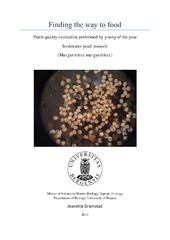Finding the way to food - Patch quality evaluation performed by young of the year freshwater pearl mussels (Margaritifera margaritifera)
Master thesis
Permanent lenke
https://hdl.handle.net/1956/8020Utgivelsesdato
2014-03-11Metadata
Vis full innførselSamlinger
Sammendrag
The freshwater pearl mussel Margaritifera margaritifera is considered a key species in aquatic environments. The juvenile stage is considered to be the most volnarable stage for the young mussels due to pollution challenges and declines in suitable host fish populations. Growth rates using different treatments with different food components were investigated in the freshwater pearl mussel, Margaritifera margaritifera. The Linear mixed effects model revealed that growth was higher when food components were present, unchanged by the absence of detritus. Young of the year mussels show positive growth when fed additional algae and when reared without detritus when the treatment is changed frequently, this categories detritus as a poor nutrition source. According to the optimal foraging theory (OFT) mussels should be expected to choose the substratum that provides the highest growth gain. However, when presented with the option mussels select the patches containing detritus regardless of its additional contents. Comparing patches differing in nutrition quality resulted in a considerable amount (90%) of the mussels chose the detritus patches with detritus when compared to patches containing only food. When allowed to choose between detritus with food components and only detritus a 50/50 division was revealed, indicating that mussels selected patches based exclusively on the presence of detritus. Detritus as natural habitats are linked with food and low velocity water; hence the mussels are attracted to the detritus.
